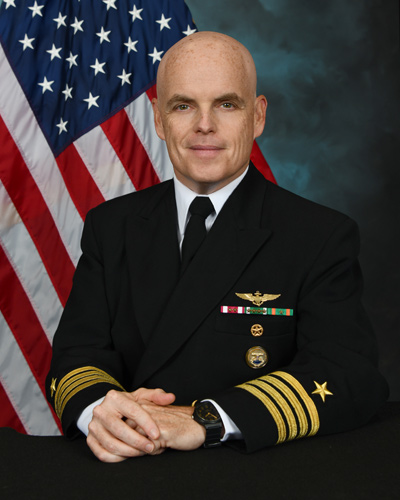 Can you tell us about the introduction of the MQ-8C into US Navy service?
Can you tell us about the introduction of the MQ-8C into US Navy service?
DM: The MQ-8C is a follow-on from the MQ-8B, which was an earlier model and different helicopter type, and while both are Group 4 aircraft, the ‘Charlie’ variant is a faster UAS [Uncrewed Aerial System] and can fly higher.
In the 2000s, the MQ-8B was supporting special operations and other campaigns, and in the 2010s there were rapid deployment capability requirements that came out for endurance, weaponisation and radar upgrades.
There was a lot of development work done by Team Fire Scout, which is the vendor team of not only the government, but Northrop Grumman, Bell Helicopter and with Leonardo as the radar integrator. All these vendors came together and developed the MQ-8C variant, based on the Bell 407 commercial helicopter platform.
We’ve done a lot of flying and testing on it and we achieved initial operation capability with the radar in 2022. So, this really is the latest capability for the Navy when it comes to shipboard based UAS.
How has the MQ-8C transformed operations for the US Navy?
On the strategic side, having an uncrewed Group 4 UAS that is launching and recovering from a ship is a unique capability for the Navy, especially with Fire Scout, and especially compared to where many other maritime services are right now.
Strategically integrating UAS has been a very complex and challenging endeavour that we’re just getting better at, and future UAS shipboard-based programmes are coming. Fire Scout has really paved the way for that.
MQ-8C brings that advanced radar capability as part of the intelligence, surveillance, reconnaissance and targeting (ISRT) sensor suite, and when you fuse that all together, it really is a force enabler for the maritime services to understand the recognised maritime picture for various decision makers, whether they be tactical or whether they be strategic.
How does Leonardo’s Osprey radar enhance the MQ-8C’s capabilities?
For the recognised maritime picture, the radar is essential. The higher you go, the longer you’re able to see out into the distance and track targets.
The data fusion system is also able to fuse the radar data and allows the operator to select different technologies, such as forward-looking infrared (FLIR) as well as some of the other capabilities for shipboard sensing. You’re able to fuse that not only on the aircraft but on the ground control system and send that to a higher echelon command and control organisation.
And those higher echelon strategists can make better-informed decisions based on what Fire Scout's providing from any of the sensors. So that makes Fire Scout a very unique platform in that it has that data fusion system and that mission payload management system to be able to do that
Why was the Leonardo Osprey 30 – known as the AN/ZPY-8 in US Navy service – selected for Fire Scout?
The US government is looking for the best-of-breed technology for the right price that fits the platform usage. The ‘Zippy 8’, as we call it, was a competitive down select and was determined to be the best value for the US Navy to provide the required radar capability that the fleet needed.
And in addition, the MQ-8C is a modified Bell 407 commercial airframe, so it’s well-known but relatively small as well. So, you needed a radar system that fits the form size that we needed, but also the weight and power requirements to make sure that all the systems could be integrated. And the Osprey 30 was the best technical solution and the best value for the Navy.
How has the introduction of the MQ-8C, including the Osprey 30/AN-ZPY-8, been received in the Navy?
As far as the MQ-8 community is concerned, those squadrons have come back to us at the programme and said it has been a game changer for them, especially compared to the MQ-8B. This has been a game changer for them on their deployments, what they're tasked to do with it, and then where that data goes and how it's used.
How do you see the future when it comes to uncrewed systems and advanced sensors?
Right now, many uncrewed systems are used as a single system to do either strategic or tactical missions. I think in the future you will see a lot of uncrewed systems augment with other uncrewed systems as a family of systems, and provide the high-echelon commander with the ability to use multiple platforms and multiple sensors and multiple data fusion engines in order to have a far better radar picture or maritime picture. This is what we call an ‘autonomous web’.
With the Navy’s development of the Osprey 30 and the data fusion package, I can see future uses for that; not only with the US Navy, but even other services and coalition partners that are interested in Fire Scout or the ZPY-8, to be able to keep honing the tactics and techniques that we've developed with the MQ-8C, and enabling that autonomous web of capabilities.
Has the relationship between Leonardo and US Navy set a new standard for US Navy and industry relations?
For me personally, from the programme perspective, I believe Leonardo has been an excellent member of Team Fire Scout, especially with the radar integration and everything that Leonardo brings to the table for that. We couldn’t have done it, and we wouldn't have made it so successful.
We’ve also received top-notch customer service from the radar team. And that's not just the programme, that's also the fleet as well. And it’s my opinion that Leonardo and the radar team has really leaned forward to make sure that we have the very best capability for the fleet.
NAVAIR Public Release SPR-2024-0123. Distribution Statement A – “Approved for public release; distribution is unlimited”

